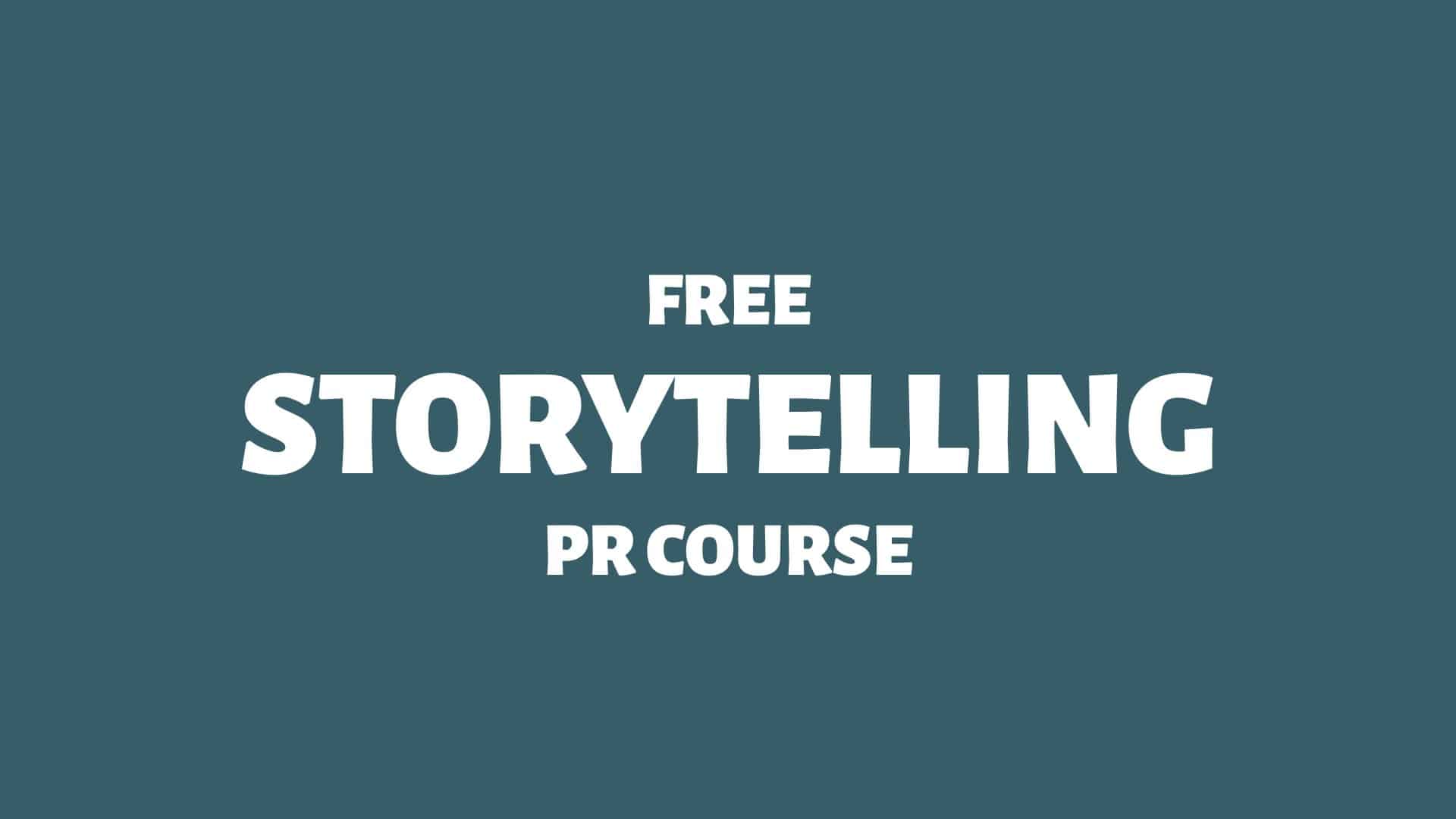What storytelling techniques can you learn in 15 minutes?
I have four perfect ways to challenge your inner storyteller if you want storytelling techniques.
And the best part:
Neither of these storytelling scripts should take you more than 15 minutes to try for yourself.
Here we go:
Storytelling Technique 1: The Pixar Pitch
Spin Academy | Online PR Courses
Storytelling Technique: The Pixar Pitch
The Pixar Pitch, made famous by Dan Pink in his book To Sell Is Human, is an excellent way to find a narrative in your business.
Emma Coats, a story artist at Pixar, has broken down the key elements of great storytelling in an elegant way that certainly could help improve your storytelling.
Here’s the Pixar Pitch script for you to try:
Once upon a time there was _________. Every day _________. One day _________. Because of that _________. Because of that _________. Until finally _________.
Jay Connor gives this example of a plot for Finding Nemo:
Once upon a time, there was a widowed fish named Marlin, who was highly protective of his only son, Nemo.
Every day Marlin warned Nemo of the ocean’s dangers and implored him not to swim far away.
One day in an act of defiance, Nemo ignores his father’s warnings and swims into the open water.
Because of that, he is captured by a diver and ends up in the fish tank of a dentist in Sydney.
Because of that Marlin sets off on a journey to recover Nemo, enlisting the help of other sea creatures along the way.
Until finally Marvin and Nemo find each other, reunite and learn that love depends on trust.
As I tried this for my own freelance business, Spin Factory, here’s what I came up with:
Once upon a time, there was no internet.
Every day, companies had to rely on a few powerful mass media distributors to market to their consumers.
One day, the advancements in information technology exploded, and all companies had to change their way of reaching out, but few knew how to do this.
Because of that, “social media experts” emerged and started making money from companies by advising them to pollute the digital universe with clutter and complexity.
Because of that, Jerry struggled with the idea that companies should strive to be clearer instead of relying on the same old spray-and-pray strategy.
Until finally, he decided to take a leap of faith together with a small group of clients, all tired of pushing one message after the other with no effect, and so the agency Spin Factory was born.
Learn more: The Pixar Pitch
💡 Subscribe and get a free ebook on how to get better PR.
Storytelling Technique 2: The Rebel Yell Statement
The Rebel Yell Statement
Copywriter Kevin Rogers published this simple yet effective script to improve your storytelling, the rebel yell statement, named after the legendary rock anthem by Billy Idol.

Here’s the rebel yell statement script for you to try:
My name is _________, I love _________ but was fed up with _________. So I created _________ that _________.
Here’s an example by Rogers on Steve Jobs:
My name is Steve, I love computers but was fed up with the snail’s pace of commercial technology. So I created a user-friendly computer that processes information faster than anything else out there today.
Here’s the rebel yell statement I wrote for this blog, Doctor Spin:
My name is Jerry, I love PR, but was fed up with “social media experts” giving clients bullshit advice. So I created Doctor Spin to share actionable insights based on academic research, hands-on experience, and passion.
Learn more: The Rebel Yell Statement
Storytelling Technique 3: Corporate Storytelling Script
“Stories have to be told or they die, and when they die, we can’t remember who we are or why we’re here.”
— Sue Monk Kidd
Spin Academy | Online PR Courses
Storytelling: The Why Prompts
Enhance your PR message with storytelling. Craft compelling public relations narratives with these simple storytelling prompts.
Here are 20 “whys” that can serve as starting points for organizations to uncover engaging and relevant stories:
These “whys” can lead to profound stories that humanise the organization, showcase its values, and build a deeper connection with its audience.
Please note. Once these stories exist, who can tell them? These stories can be immensely useful for corporate communication, but if all coworkers know these stories, that is the most potent propagation.
Learn more: The Story First: Mapping Whys for Storytelling
💡 Subscribe and get a free ebook on how to get better PR.

Storytelling Technique 4: The Lottery Question
Imagine your organisation won the lottery; money is no longer a primary motivator.
You and your co-workers are now taken care of financially, and the brand has earned notoriety by having the winning ticket.
Taking money out of the equation might seem counterintuitive for a business. I’m all about the bottom line, too. Still, this is about how to improve your storytelling.
Here’s the Lottery Question script for you to try:
With more money than you need in the bank, what would your company do next?
Here’s how I imagine this scenario for Spin Factory:
Great minds need time for reflection to grow stronger and happier, so we would have more vacation time than the usual industry standard.
Each week, we would set aside time to explore new academic research and interact with the scientific community on behavioural research, human psychology, and online marketing.
I wouldn’t go out on a frantic hiring spree but rather invest heavily in the people we already have on board.
We would say no to working with clients if we don’t feel passionate about their business objectives.
Our kickoffs, conferences and team-building travels would be so epic that it would be ridiculous.
We would do pro bono work for important non-profits that otherwise can’t afford our expertise.
Despite the success, we would still work hard because we consider hard work a virtue and a way of life.
As follows:
What could you do to implement your lottery ideas today — even without winning an actual lottery?
Storytelling Techniques for Public Relations
In public relations, mastering storytelling techniques is paramount for professionals seeking to effectively convey messages and build meaningful connections with their target audiences.
Storytelling is a powerful tool for crafting narratives that resonate with individuals on an emotional level, capturing their attention and fostering engagement.
By harnessing the principles of storytelling, public relations professionals can transform mundane information into compelling stories that evoke empathy, understanding, and trust among stakeholders, influencers, and publics.
Moreover, narratives can humanise brands, making them relatable and memorable in the minds of consumers. As such, integrating storytelling into public relations strategies not only enhances brand perception but also facilitates the communication of key messages in an authentic and impactful manner.

THANKS FOR READING.
Need PR help? Hire me here.

PR Resource: PR Toolbox
Spin Academy | Online PR Courses

Spin’s PR School: Free Storytelling PR Course
Elevate your public relations game with this free Storytelling PR Course. Learn essential and timeless storytelling techniques for effective communication.
Storytelling Elements
Storytelling Scripts
Storytelling Inspiration
Learn more: All Free PR Courses
💡 Subscribe and get a free ebook on how to get better PR.

PR Resource: Ethos, Pathos, and Logos
Ethos, Pathos, and Logos: Three Modes of Persuasion
Ethos, pathos, and logos are three modes of persuasion recognised since ancient Greece, and they play an essential role in public relations.
“Aristotle’s three modes of rhetorical persuasion are ethos, pathos, and logos, which are based on moral competence, emotional appeal, and reason.”
Source: Sino-US English Teaching 1Lin, W. (2019). Three Modes of Rhetorical Persuasion. Sino-US English Teaching. https://doi.org/10.17265/1539 – 8072⁄2019.03.003

In PR, these three modes of persuasion are often combined to create compelling messages that resonate with the audience on multiple levels. 2Modes of persuasion. (2023, September 27). In Wikipedia. https://en.wikipedia.org/wiki/Modes_of_persuasion
By understanding and applying the principles of ethos, pathos, and logos, PR professionals can craft messages that resonate deeply with their audience, driving action and fostering lasting relationships.
Learn more: Ethos, Pathos, and Logos in Public Relations
PR Resource: Drafting
Spin Academy | Online PR Courses
Communication Skill: Drafting
Drafting, creating, and refining written documents are fundamental communication skills crucial in everyday life. From composing emails and writing reports to crafting personal letters or social media posts, the ability to draft and edit documents ensures clarity, coherence, and effectiveness in conveying messages.
“The first draft of anything is shit.”
— Ernest Hemingway
Many individuals struggle with writing not because they lack ideas but because they underestimate the power of revision. The initial draft is rarely perfect; it’s through revising this draft — transforming it into a second, third, or even fourth draft — that one hones the message, sharpens the language, and strengthens the overall communication.
Developing a habit of drafting and editing allows for exploring ideas, refining thought, and eliminating ambiguity, making the final product more impactful and understood by its intended audience.
To become better at drafting, consider these five tips:
Incorporating these strategies into your writing routine can elevate your drafting skills, leading to precise, compelling, and effective written communication in every aspect of your life.
Learn more: Communication Skills (That Everyone Should Learn)
💡 Subscribe and get a free ebook on how to get better PR.

Annotations
| 1 | Lin, W. (2019). Three Modes of Rhetorical Persuasion. Sino-US English Teaching. https://doi.org/10.17265/1539 – 8072⁄2019.03.003 |
|---|---|
| 2 | Modes of persuasion. (2023, September 27). In Wikipedia. https://en.wikipedia.org/wiki/Modes_of_persuasion |


